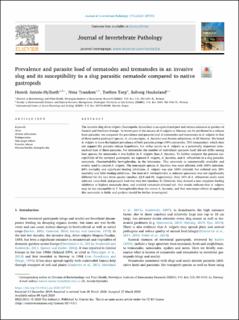| dc.description.abstract | The invasive slug Arion vulgaris (Gastropoda: Arionidae) is an agricultural pest and serious nuisance in gardens of Central and Northern Europe. To investigate if the success of A.vulgaris in Norway can be attributed to a release from parasites, we compared the prevalence and parasite load of nematodes and trematodes in A. vulgaris to that of three native gastropod species, A. circumscriptus, A. fasciatus and Arianta arbustorum, in SE Norway. We found A. vulgaris to have the highest prevalence of both parasite groups (49% nematodes, 76% trematodes), which does not support the parasite release hypothesis, but rather points to A. vulgaris as a potentially important intermediate host of these parasites. For trematodes the number of individuals (parasite load) did not differ among host species; for nematodes it was higher in A. vulgaris than A. fasciatus. To further compare the parasite susceptibility of the surveyed gastropods, we exposed A. vulgaris, A. fasciatus, and A. arbustorum to a slug parasitic nematode, Phasmarhabditis hermaphrodita, in the laboratory. This nematode is commercially available and widely used to control A. vulgaris. The non-target species A. fasciatus was most affected, with 100% infection, 60% mortality and significant feeding inhibition. A. vulgaris was also 100% infected, but suffered only 20% mortality and little feeding inhibition. The load of P. hermaphrodita in infected specimens was not significantly different for the two Arion species (median: 22.5 and 45, respectively). Only 35% of A. arbustorum snails were infected, none died, and parasite load was very low (median: 2). However, they showed a near complete feeding inhibition at highest nematode dose, and avoided nematode-infested soil. Our results indicate that A. vulgaris may be less susceptible to P. hermaphrodita than the native A. fasciatus, and that non-target effects of applying this nematode in fields and gardens should be further investigated. | |
